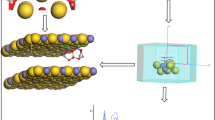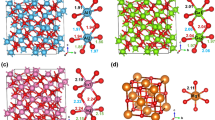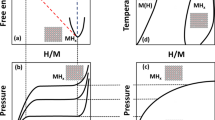Abstract
A density functional theory parameterized lattice gas cluster expansion of oxygen on an Fe(100) surface is developed in the presence and absence of an applied positive and negative external electric field, characterizing the heterogeneity in oxygen’s surface distribution and the effect of an external electric field on the lateral interactions between the adsorbates. We show that the presence of a negative electric field tends to weaken both attractive and repulsive interactions while the positive electric field tends to strengthen these interactions, altering surface distributions and ground state configurations. Since lateral interactions have been shown to play a critical role in defining catalytic behavior, the application of an applied electric field has the potential to be a useful tool in adjusting critical chemical properties of Fe-based hydrodeoxygenation catalysts, by decreasing the repulsive interactions between the adspecies in the presence of a negative field and thereby mitigating the formation of an oxide.








Similar content being viewed by others
References
Wang H, Male J, Wang Y (2013) Recent advances in hydrotreating of pyrolysis bio-oil and its oxygen-containing model compounds. ACS Catal 3(5):1047–1070
Sun J, Karim AM, Zhang H, Kovarik L, Li XS, Hensley AJR, McEwen J-S, Wang Y (2013) Carbon-supported bimetallic Pd–Fe catalysts for vapor-phase hydrodeoxygenation of guaiacol. J Catal 306:47–57
Hong Y, Zhang H, Sun J, Karim AM, Hensley AJR, Gu M, Engelhard MH, McEwen J-S, Wang Y (2014) Synergistic catalysis between Pd and Fe in gas phase hydrodeoxygenation of m-cresol. ACS Catal 4(10):3335–3345
Nie L, de Souza PM, Noronha FB, An W (2014) Selective conversion of m-cresol to toluene over bimetallic Ni–Fe catalysts. J Phys Chem C 388:47–55
Sitthisa S, An W, Resasco DE (2011) Selective conversion of furfural to methylfuran over silica-supported Ni Fe bimetallic catalysts. J Catal 284(1):90–101
Che F, Ha S, McEwen J-S (2016) Elucidating the field influence on the energetics of the methane steam reforming reaction: a density functional theory study. Appl Catal B 195(1):77–89
Che F, Gray JT, Ha S, McEwen J-S (2016) Improving Ni catalysts using electric fields: a DFT and experimental study of the methane steam reforming reaction. ACS Catal 7(1):551–562
Che F, Ha S, McEwen J-S (2017) Hydrogen oxidation and water dissociation over an oxygen-enriched Ni/YSZ electrode in the presence of an electric field: a first principles-based microkinetic model. Ind Eng Chem Res 56(5):1201–1213
Che F, Gray JT, Ha S, McEwen J-S (2015) Catalytic water dehydrogenation and formation on nickel: dual path mechanism in high electric fields. J Catal 332:187–200
Che F, Ha S, McEwen J-S (2017) Catalytic reaction rates controlled by metal oxidation state: C–H bond cleavage in methane over nickel-based catalysts. Angew Chem Int Ed 129(13):3611–3615
Che F, Gray JT, Ha S, McEwen J-S (2017) Reducing reaction temperature, steam requirements, and coke formation during methane steam reforming using electric fields: a microkinetic modeling and experimental study. ACS Catal 7(10):6957–6968
Hong Y, Hensley AJR, McEwen J-S, Wang Y (2016) Perspective on catalytic hydrodeoxygenation of biomass pyrolysis oils: essential roles of Fe-based catalysts. Catal Lett 146(9):1621–1633
Van De Walle A, Ceder G (2002) Automating first-principles phase diagram calculations. J Ph Equilib 23(4):348–359
Stampfl A, Kreuzer HJ, Payne SH, Pfnür H, Scheffler M (1999) First-principles theory of surface thermodynamics and kinetics. Phys Rev Lett 83(15):2993
McEwen J-S, Eichler A (2007) Phase diagram and adsorption-desorption kinetics of CO on Ru(0001) from first principles. J Chem Phys 129(9):094701
McEwen J-S, Payne SH, Stampfl C (2002) Phase diagram of O/Ru(0001) from first principles. Chem Phys Lett 361(3):317–320
Bray JM, Skavdahl IJ, McEwen J-S, Schneider WF (2014) First-principles reaction site model for coverage-sensitive surface reactions: Pt(111)–O temperature programmed desorption. Surf Sci 622:L1–L6
Vignola E, Steinmann SN, Vandegehuchte BD, Curulla D, Stamatakis M, Sautet P (2017) A machine learning approach to graph-theoretical cluster expansions of the energy of adsorbate layers. J Chem Phys 147(5):054106
Reuter K, Stampfl C, Scheffler M (2005) Ab initio atomistic thermodynamics and statistical mechanics of surface properties and functions. In: Yip S (ed) Handbook of materials modeling, vol. 1. Springer, Dordrecht, pp 149–194
Asthagiri A, Janik MJ (eds) (2013) Computational catalysis. Royal Society of Chemistry, Cambridge
Zhang P (1993) Model selection via multifold cross validation. Ann Stat 21(1):299–313
Shao J (2012) Linear model selection by cross-validation. J Am Stat Assoc 88(422):486
Baumann K (2003) Cross-validation as the objective function for variable-selection techniques. TrAC 22(6):395–406
McEwen J-S, Payne SH, Kreuzer HJ, Kinne M, Denecke R, Steinrück HP (2003) Adsorption and desorption of CO on Pt(111): a comprehensive analysis. Surf Sci 545(1):47–69
Van De Walle A, Asta M, Ceder G (2002) The Alloy Theoretic Automated Toolkit: a user guide. arXivorg 26(4):539–553
Kresse G, Furthmüller J (1996) Efficiency of ab-initio total energy calculations for metals and semiconductors using a plane-wave basis set. Comput Mater Sci 6(1):15–50
Kresse G, Hafner J (1993) Ab initio molecular dynamics for liquid metals. Phys Rev B 47(1):558–561
Błoński P, Kiejna A, Hafner J (2005) Theoretical study of oxygen adsorption at the Fe (110) and (100) surfaces. Surf Sci 590(1):88–100
Freitas RRQ, Rivelino R, de Brito Mota F, de Castilho CMC (2012) Dissociative adsorption and aggregation of water on the Fe(100) surface: a DFT study. J Phys Chem C 116(38):20306–20314
Kittel C (2004) Introduction to solid state physics, 8 edn. Wiley, New York
Blöchl PE (1994) Projector augmented-wave method. Phys Rev B 50(24):17953
Kresse G, Joubert D (1999) From ultrasoft pseudopotentials to the projector augmented-wave method. Phys Rev B 59(3):1758–1775
Hammer B, Hansen LB, Nørskov JK (1999) Improved adsorption energetics within density-functional theory using revised Perdew–Burke–Ernzerhof functionals. Phys Rev B 59(11):7413–7421
Hensley AJR, Ghale K, Rieg C, Dang T, Anderst E, Studt F, Campbell CT, McEwen J-S, Xu Y (2017) DFT-based method for more accurate adsorption energies: an adaptive sum of energies from RPBE and vdW density functionals. J Phys Chem C 121(9):4937–4945
Stevens ED, Rys J, Coppens P (1978) Quantitative comparison of theoretical calculations with the experimentally determined electron density distribution of formamide. J Am Chem Soc 100(8):2324–2328
Maintz S, Deringer VL, Tchougréeff AL, Dronskowski R (2016) LOBSTER: a tool to extract chemical bonding from plane-wave based DFT. J Comput Chem 37(11):1030–1035
Maintz S, Deringer VL, Tchougréeff AL, Dronskowski R (2013) Analytic projection from plane-wave and PAW wavefunctions and application to chemical-bonding analysis in solids. J Comput Chem 34(29):2557–2567
Deringer VL, Tchougréeff AL, Dronskowski R (2011) Crystal orbital hamilton population (COHP) analysis as projected from plane-wave basis sets. J Phys Chem A 115(21):5461–5466
Dronskowski R, Bloechl PE (1993) Crystal orbital Hamilton populations (COHP): energy-resolved visualization of chemical bonding in solids based on density-functional calculations. J Phys Chem 97:8617–8624
Maintz S, Esser M, Dronskowski R (2016) Efficient rotation of local basis functions using real spherical harmonics. Acta Phys Pol B 47(4):1165–1175
Neugebauer J, Scheffler M (1992) Adsorbate-substrate and adsorbate-adsorbate interactions of Na and K adlayers on Al(111). Phys Rev B 46(24):16067–16080
Deshlahra P, Wolf EE, Schneider WF (2009) A periodic density functional theory analysis of CO chemisorption on Pt(111) in the presence of uniform electric fields. J Phys Chem A 113(16):4125–4133
Feibelman PJ (2001) Surface-diffusion mechanism versus electric field: Pt/Pt(001). Phys Rev B 64(12):2491
Donati F, Sessi P, Achilli S, Li Bassi A, Passoni M, Casari CS, Bottani CE, Brambilla A, Picone A, Finazzi M, Duò L, Trioni MI, Ciccacci F (2009) Scanning tunneling spectroscopy of the Fe(001)—p(1 × 1)Osurface. Phys Rev B 79(19):195430–195436
Collinge G, McEwen J-S (2018) Estimation of errors in effective cluster interactions of lattice gas models based on ab initio calculations. (In Preparation)
Acknowledgements
J.B. and J.-S.M. were primarily funded by the U.S. Department of Energy, Office of Basic Energy Sciences, Division of Chemical Sciences, Biosciences and Geosciences (DE-SC0014560). G.C., NSF Graduate Research Fellow, gratefully acknowledges financial support from the National Science Foundation Graduate Research Fellowship Program. G.C. also acknowledges the NSF EAPSI fellowship program under award number 1613890. J.B., Seattle Chapter ARCS Fellow, gratefully acknowledges financial support from the Achievement Rewards for College Scientists Foundation. The Pacific Northwest National Laboratory is operated by Battelle for the U.S. DOE.
Author information
Authors and Affiliations
Corresponding author
Electronic supplementary material
Below is the link to the electronic supplementary material.
Rights and permissions
About this article
Cite this article
Bray, J., Collinge, G., Stampfl, C. et al. Predicting the Electric Field Effect on the Lateral Interactions Between Adsorbates: O/Fe(100) from First Principles. Top Catal 61, 763–775 (2018). https://doi.org/10.1007/s11244-018-0944-z
Published:
Issue Date:
DOI: https://doi.org/10.1007/s11244-018-0944-z




